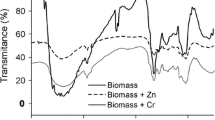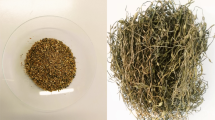Abstract
Experiments with free cell biomass (cells + exopolysaccharides) ofRhizobium BJVr 12 (mungbean isolate) showed that amount ofCr3+ ion sorbed is influenced by the amount of biomass toCr3+ concentration ratio and time of contact. A ratio of 0.5 gfresh biomass to 10.0 ml 5.03 ppm Cr3+ sorbed 0.0275 mg Crequivalent to an uptake of 2.86 mg Cr g-1 dry biomass and 1.0g: 10.0 ml sorbed 0.0366 mg Cr equivalent to an uptake of 1.9 mg Crg-1 biomass. Immobilized cell biomass in ceramic beads and inaquacel (a porous cellulose carrier with a charged surface) were moreefficient than free cell biomass in adsorbing Cr(III). A reduction of49.7percnt; of Cr(III) for free cells, 95.6% for cells immobilized inceramic beads and 94.6% for cells in aquacel was achieved after 48hours under shaken conditions. Sorption capacities of immobilized cellbiomass in ceramic beads and aquacel ranged from 5.01 to 5.06 mg Crg-1 dry cell biomass. The biosorption of Cr3+follows generally the Langmuir and Freundlich models of adsorption at lowCr3+ concentrations. The Langmuir constant for immobilizedcells in ceramic beads are: Q0, 0.065 mmol Crg-1 biomass; b (affinity constant), - 694 lmmol-1 Cr and for cells in aquacel Q, 0.07 mmol Crg-1 biomass; b, - 694 l mmol Cr g-1 Cr. TheFreundlich constants are: K, 0.071 mmol Cr g-1 biomass; n,0.13 g-1 biomass l-1 and for aquacel: K, 0.074mmol g-1 biomass; n, 0.13 g-1 biomass. Biotrapsmade up of immobilized cells in ceramic beads and aquacel were tested foradsorbing Cr(III) using two different flow rates: 0.5 ml/min and 1.5 ml/min.A significantly higher amount of Cr(III) was adsorbed at the lower flow rateof 0.5 ml/min. Biosorption of Cr3+ is competitive. Thetreatment of a waste water sample containing 6.03 ppm Cr3+ andother cations with the biomass reduced the Cr3+ concentrationto that much lower than for the test solution containing only Cr. Recoveryof biosorbed Cr(III) was by treatment at a different pH using dilute HClsolution. Recovery was higher for cells imbibed in ceramic beads thanaquacel. Percentage recoveries for cells in aquacel are 46.4% at pH1.0, 33.0% at pH 3.0 and 6.6% at pH 6.0–7.0. For cellsin ceramic beads, percentage recoveries are: 93.1% at pH 1.0,75.6% at pH 3.0 and 16.4% at pH 6.0–7.0. Biosorption ofCr3+ by cells immobilized in ceramic beads is reversible butonly partially for cells in aquacel.
Similar content being viewed by others
References
Shumate SE II & Strandberg GW (1985) Accumulation of metals by microbial cells. Comprehensive Biotechnology. Vol. 4. Pergamon Press, New York
Gadd GM (1992) Biosorption. J. Chem. Technol. Biotechol. 55: 302–304.
Friedman BA & Dugan PR (1968) Concentration and accumulation of metallic ions by the bacterium Zoogloea. Dev. Ind. Microbiol. 9: 381–388
Norberg AB & Persson H (1984) Accumulation of heavy metal ions by Zoogloea ramigera. Biotechnol. Bioeng. 26: 239–246
Geesey GG & Jang L (1989) Interactions between metal ions and capsular polymers. In: Beveridge TJ & Doyle RJ (Eds) Metal Ions and Bacteria (pp 325–358). John Wiley and Sons, New York
Brown MJ & Lester JN (1979) Metal removal in activated sludge: the role of bacterial extracellular polymers.Water Res. 13: 817–837
Cotoras D, Millar M, Viedma P, Pimentel J & Mestre A (1992) Biosorption of metal ions by Azobacter vinelandii. World J. Microbiol. Biotechnol. 8: 319–323
Dudman WF (1984) The polysaccharides and oligosaccharides of Rhizobiumand the role in the infection process. In: Veeger C & Newton WE (Eds) Advances in Nitrogen Fixation Research (pp 397–404). Nijhoff/Dr. W. Junk Publishers, The Hague, Netherlands
Douka CE & Xenoulis AC (1988) Beneficial effects of biological nitrogen fixation on the reduction of: I. Metal toxicity of the biomas produced. II. Radioisotope uptake following the Chernobyl Fallout. In: Bothe H, De Bruijn J & Newton WE (Eds) Nitrogen Fixation: Hundred Years After (p. 812). Gustav Fisher, Stuttgart
Mamaril JC, Paner ET, Capuno VT & Trinidad LC (1989) Reduction of heavy metal concentration in liquids by Rhizobiumpolysaccharides. Asean J. Sci. Technol. Dev. 6 (2): 75–86
Mamaril JC, Trinidad LC, Tolentino LSP & Capuno VT (1991) Heavy metal resistance of selected Rhizobiumstrains. Trans. Nat. Acad. Sci. Technol. (Philippines) 13: 517–534
Shi X, Dalal NS & Vallyathan V(1991) One electron reduction of carcinogen chromate by microsomes, mitochondria, and Escherichia coli. Identification of Cr (V) and OH radical. Arch. Biochem. Biophys. 290: 381–386
Wood JM & Wang H (1983) Microbial resistance to heavy metals. Environ. Sci. Technol. 17: 582A–590A
Vincent JM (1970) A Manual for the Practical Study of Root Nodule Bacteria (164 pp). Burgess and Sons Ltd., Great Britain
Sutherland IW (1985) Biosynthesis and composition of gram-negative bacterial extracellular and wall polysaccharides. Ann. Rev. Microbiol. 39: 243–270
Beveridge TJ (1988) The bacterial surface: general considerations toward design and function. Can. J. Microbiol. 34: 363–372
Dudman WJ (1976) The extracellular polysaccharides of Rhizobium japonicumcompositional studies. Carbohydrate Res. 46: 97–110
Rai LC & Mallick N (1992) Removal and assessment of Cu and Fe to Anabaena doliolumand Chlorella vulgarisusing free and immobilized cells. World J. Microbiol. Biotechnol. 8: 110–114
Kierstan M & Bucke (1977) The immobilization of microbial cells, subcellular organelles and enzymes in calcium alginate gels. Biotechnol. Bioeng. 9: 387–397
Zhou JL & Kiff RJ (1991) The uptake of copper from aqueous solution by immobilized fungal biomass. J. Chem. Technol. Biotechnol. 56: 317–329
Mattuschka B & Straube G (1993) Biosorption of metals by a waste biomass. J. Chem. Tech. Biotechnol. 58: 57–63
Keenan CW, Kleinfelter DC & Wood JH (1980) General College Chemistry (p 359). Harper and Row Publishers Inc., New York
Author information
Authors and Affiliations
Rights and permissions
About this article
Cite this article
Mamaril, J.C., Paner, E.T. & Alpante, B.M. Biosorption and desorption studies of chromium (III) by free and immobilized Rhizobium (BJVr 12) cell biomass. Biodegradation 8, 275–285 (1997). https://doi.org/10.1023/A:1008213712910
Issue Date:
DOI: https://doi.org/10.1023/A:1008213712910




